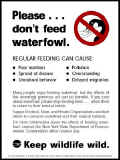|
Feeding the Ducks
 Most
ponds and lakes will attract ducks - and duck feeders. Most
ponds and lakes will attract ducks - and duck feeders.
At
Coy Pond and South Park Road particularly we see groups of people, often
with babies and young children, enjoying a bit of quiet time by the water, throwing bread
for the ducks. Sometimes whole loaves, maybe two. Sometimes
not just bread - we've even seen plates of leftovers such as spaghetti
bolognese left out beside Coy Pond!
It
is hard to resist a duck begging for attention, and it
would seem that providing food for wildfowl would make them
healthy and happy, but it doesn't.
Their health
 When
wild ducks are fed human food such as bread their organs become engorged
and fatty, which can cause them to suffer from heart
disease, liver problems and other health complications. When
wild ducks are fed human food such as bread their organs become engorged
and fatty, which can cause them to suffer from heart
disease, liver problems and other health complications.
Waterfowl
at artificial feeding sites are often found to suffer from poor
nutrition. In a natural setting they will seek out a variety of
nutritious foods such as aquatic plants, natural grains, and
invertebrates. Bread is very low in protein, contains additives
that wildfowl aren't built to cope with, and it's a very poor substitute
for natural foods.
Natural
food is usually available over a wide area. At some artificial feeding
sites, competition for each crust is high. Some ducks and geese
(usually the youngest) are unable to compete for handouts. Ducks
become unnaturally aggressive towards each other and a nuisance to
humans.
Feeding
will also create unnaturally high populations of waterfowl at a pond,
and diseases generally not transmissible in the wild will flourish in
overcrowded and unsanitary conditions.
Visible
symptoms of poor nutrition and advanced stages of starvation are often
seen at artificial feeding sites; ducks may have drooping wings or may
lose their ability to fly; they become sluggish and can't escape from
predators such as foxes.
Your Health
At
some sites there are so
many people feeding the ducks that uneaten food is left to rot.
Decaying food pollutes the water and attracts foxes that prey on ducks. Food left for ducks will also attract
vermin.
Waterfowl
and rats will defecate where they feed - often at the pond edge. And
naturally,
the amount of faeces they produce is directly proportional to the amount
they eat. It's not exactly a healthy environment, especially for
young children and the elderly.
Did You Know?
Ducks and other waterfowl die in greater numbers than most people realise because corpses are so rarely
seen; a dead or dying duck
will be taken by a fox or other predator before it's found by you or me.
They will live much longer eating foods growing naturally in their
environment. Please try to resist feeding them, especially with
food intended for humans.
|